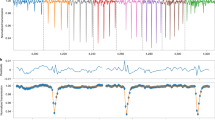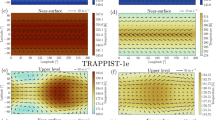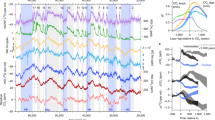Abstract
Carbon dioxide occurs naturally throughout Earth’satmosphere. In the thermosphere, CO2 is the primary radiative cooling agent and fundamentally affects the energy balance and temperature of this high-altitude atmospheric layer1,2. Anthropogenic CO2 increases are expected to propagate upward throughout the entire atmosphere, which should result in a cooler, more contracted thermosphere3,4,5. This contraction, in turn, will reduce atmospheric drag on satellites and may have adverse consequences for the orbital debris environment that is already unstable6,7. However, observed thermospheric mass density trends derived from satellite orbits are generally stronger than model predictions8,9, indicating that our quantitative understanding of these changes is incomplete. So far, CO2 trends have been measured only up to 35 km altitude10,11,12. Here, we present direct evidence that CO2 concentrations in the upper atmosphere—probably the primary driver of long-term thermospheric trends—are increasing. We analyse eight years of CO2 and carbon monoxide mixing ratios derived from satellite-based solar occultation spectra. After correcting for seasonal–latitudinal and solar influences, we obtain an estimated global increase in COx (CO2 and CO, combined) concentrations of 23.5±6.3 ppm per decade at an altitude of 101 km, about 10 ppm per decade faster than predicted by an upper atmospheric model. We suggest that this discrepancy may explain why the thermospheric density decrease is stronger than expected.
This is a preview of subscription content, access via your institution
Access options
Subscribe to this journal
Receive 12 print issues and online access
$259.00 per year
only $21.58 per issue
Buy this article
- Purchase on Springer Link
- Instant access to full article PDF
Prices may be subject to local taxes which are calculated during checkout




Similar content being viewed by others
References
Roble, R. G. Energetics of the mesosphere and thermosphere. Geophys. Monogr. Ser. 87, 1–21 (1995).
Mlynczak, M. G. et al. Observations of infrared radiative cooling in the thermosphere on daily to multiyear timescales from the TIMED/SABER instrument. J. Geophys Res. 115, A03309 (2010).
Roble, R. G. & Dickinson, R. E. How will changes in carbon dioxide and methane modify the mean structure of the mesosphere and thermosphere? Geophys. Res. Lett. 16, 1441–1444 (1989).
Laštovička, J. et al. Emerging pattern of global change in the upper atmosphere and ionosphere. Ann. Geophys. 26, 1255–1268 (2008).
Qian, L., Laštovička, J., Roble, R. G. & Solomon, S. C. Progress in observations and simulations of global change in the upper atmosphere. J. Geophys Res. 116, A00H03 (2011).
Lewis, H. G., Saunders, A., Swinerd, G. & Newland, R. J. Effect of thermospheric contraction on remediation of the near-Earth space debris environment. J. Geophys Res. 116, A00H08 (2011).
Liou, J-C. & Johnson, N. L. Instability of the present LEO satellite populations. Adv. Space Res. 41, 1046–1053 (2008).
Emmert, J. T., Picone, J. M. & Meier, R. R. Thermospheric global average density trends, 1967–2007, derived from orbits of 5000 near-Earth objects. Geophys. Res. Lett. 35, L05101 (2008).
Cnossen, I. in Greenhouse Gases—Emission, Measurement and Management (ed. Liu, G.) 315–336 (InTech, 2012); available at http://www.intechopen.com/books/greenhouse-gases-emission-measurement-and-management/climate-change-in-the-upper-atmosphere.
Keeling, R. F., Piper, S. C., Bollenbacher, A. F. & Walker, J. S. Trends: A Compendium of Data on Global Change. Carbon Dioxide Information Analysis Center (Oak Ridge National Laboratory, 2009).
Bischof, W., Borchers, R., Fabian, P. & Krüger, B. C. Increased concentration and vertical distribution of carbon dioxide in the stratosphere. Nature 316, 708–710 (1985).
Foucher, P. Y. et al. Carbon dioxide atmospheric vertical profiles retrieved from space observation using ACE-FTS solar occultation instrument. Atmos. Chem. Phys. 11, 2455–2470 (2011).
López-Puertas, M., Lopez-Valverde, M. A., Garcia, R. R. & Roble, R. G. in Atmospheric Science Across the Stratopause (eds Siskind, D. E. et al.) 83–100 (Geophys. Monog. Series, Vol. 123, American Geophysical Union, 2000).
Beagley, S. R. et al. First multi-year occultation observations of CO2 in the MLT by ACE satellite: Observations and analysis using the extended CMAM. Atmos. Chem. Phys. 10, 1133–1153 (2010).
Bernath, P. F. et al. Atmospheric Chemistry Experiment (ACE): Mission overview. Geophys. Res. Lett. 32, L15S01 (2005).
Conway, T. J. et al. Evidence for interannual variability of the carbon cycle from the National Oceanic and Atmospheric Administration/Climate Monitoring and Diagnostics Laboratory Global Air Sampling Network. J. Geophys Res. 99, 22831–22855 (1994).
Boone, C. D. et al. Retrievals for the atmospheric chemistry experiment Fourier-transform spectrometer. Appl. Opt. 44, 7218–7231 (2005).
Qian, L., Roble, R. G., Solomon, S. C. & Kane, T. J. Calculated and observed climate change in the thermosphere, and a prediction for solar cycle 24. Geophys. Res. Lett. 33, L23705 (2006).
Akmaev, R. A., Fomichev, V. I. & Zhu, X. Impact of middle-atmospheric composition changes on greenhouse cooling in the upper atmosphere. J. Atmos. Solar-Terr. Phys. 68, 1879–1889 (2006).
Hoffmann, P., Rapp, M., Singer, W. & Keuer, D. Trends of mesospheric gravity waves at northern middle latitudes during summer. J. Geophys Res. 116, D00P08 (2011).
Garcia, R. R., Randel, W. J. & Kinnison, D. E. On the determination of age of air trends from atmospheric trace species. J. Atmos. Sci. 68, 139–154 (2011).
Emmert, J. T., Lean, J. L. & Picone, J. M. Record-low thermospheric density during the 2008 solar minimum. Geophys. Res. Lett. 37, L12102 (2010).
American Institute of Aeronautics and Astronautics Atmospheric Effects of Chemical Rocket Propulsion (AIAA, 1991).
Isakowitz, S. J., Hopkins, J. P. Jr & Hopkins, J. B. International Reference Guide to Space Launch Systems 3rd edn (AIAA, 1999).
Emmert, J. T. & Picone, J. M. Statistical uncertainty of 1967–2005 thermospheric density trends derived from orbital drag. J. Geophys. Res. 116, A00H09 (2011).
Acknowledgements
Work at NRL was funded by the Office of Naval Research and the NASA Causes and Consequences of the Minimum of Solar Cycle 24 Program. The ACE mission is funded primarily by the Canadian Space Agency. We thank S. McLeod and K. Walker for producing and providing access to the ACE retrievals, and the National Center for Atmospheric Research for providing the global mean model source code (http://www.hao.ucar.edu/modeling/tgcm/). T. Conway and P. Tans of NOAA/ESRL provided the global mean tropospheric CO2 data. J.T.E. thanks D. Siskind and R. Meier for beneficial discussions and suggestions.
Author information
Authors and Affiliations
Contributions
J.T.E. conceived the study, analysed the data and model output, and prepared the manuscript. M.H.S. and D.P.D. conducted the model simulations. M.H.S. calculated carbon emissions from space vehicle launches. P.F.B. and C.D.B. provided guidance on the use of the ACE-FTS retrievals. C.D.B. developed the ACE-FTS retrieval algorithms. All authors discussed the results, interpretations and implications, and contributed to the manuscript.
Corresponding author
Ethics declarations
Competing interests
The authors declare no competing financial interests.
Supplementary information
Supplementary Information
Supplementary Information (PDF 1831 kb)
Rights and permissions
About this article
Cite this article
Emmert, J., Stevens, M., Bernath, P. et al. Observations of increasing carbon dioxide concentration in Earth’s thermosphere. Nature Geosci 5, 868–871 (2012). https://doi.org/10.1038/ngeo1626
Received:
Accepted:
Published:
Issue Date:
DOI: https://doi.org/10.1038/ngeo1626
This article is cited by
-
Atmospheric impacts of the space industry require oversight
Nature Geoscience (2022)
-
Response of the mesosphere-thermosphere-ionosphere system to global change - CAWSES-II contribution
Progress in Earth and Planetary Science (2014)
-
Up and down
Nature Geoscience (2013)
-
Rise in upper-atmospheric carbon
Nature Geoscience (2012)



